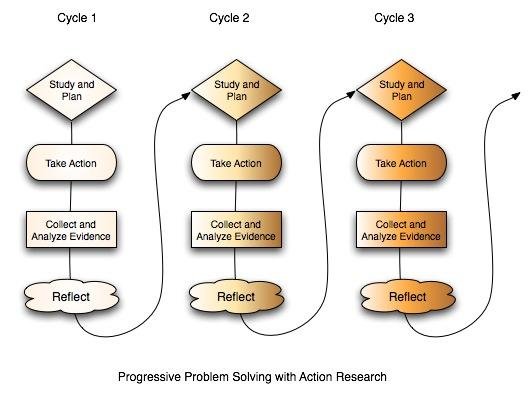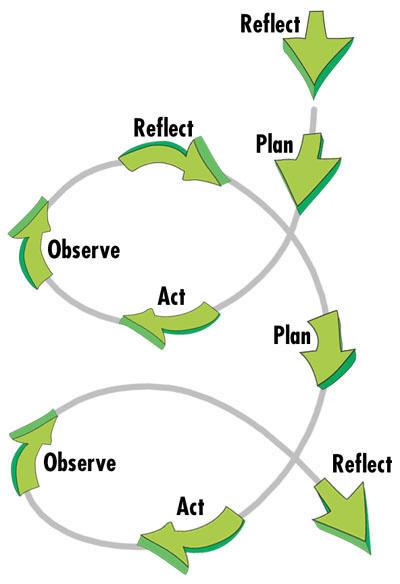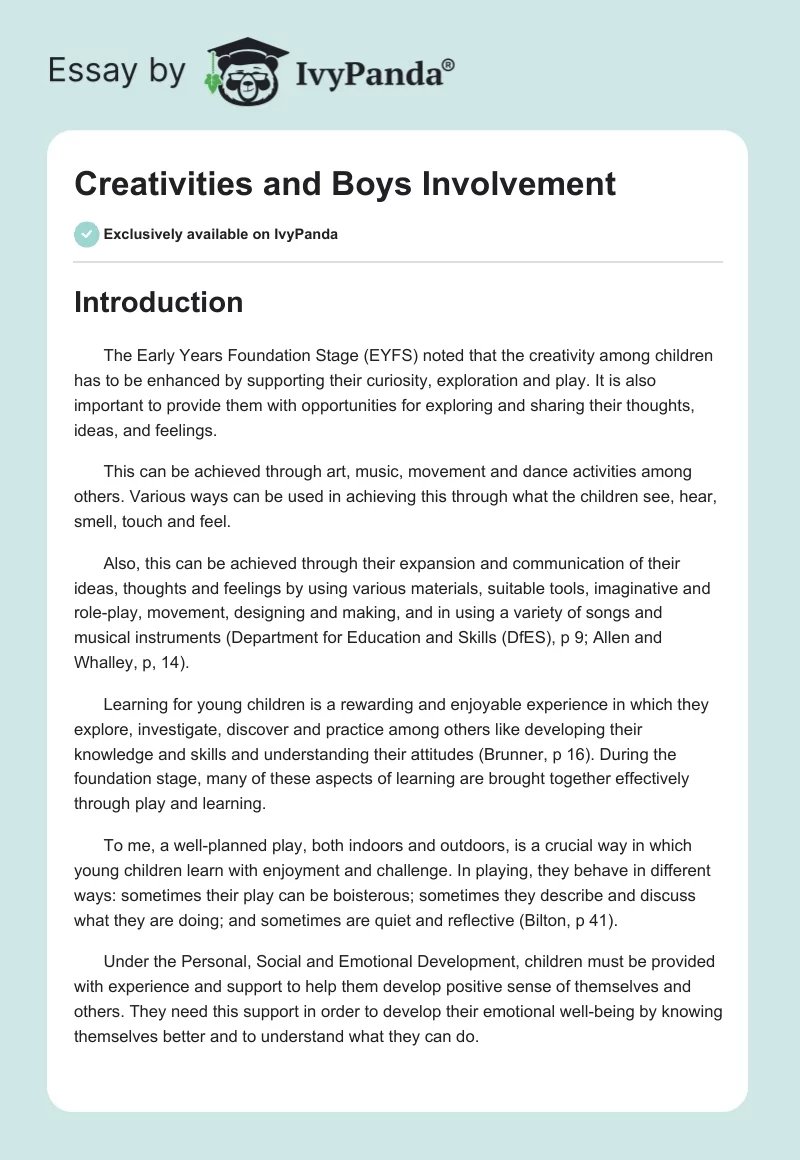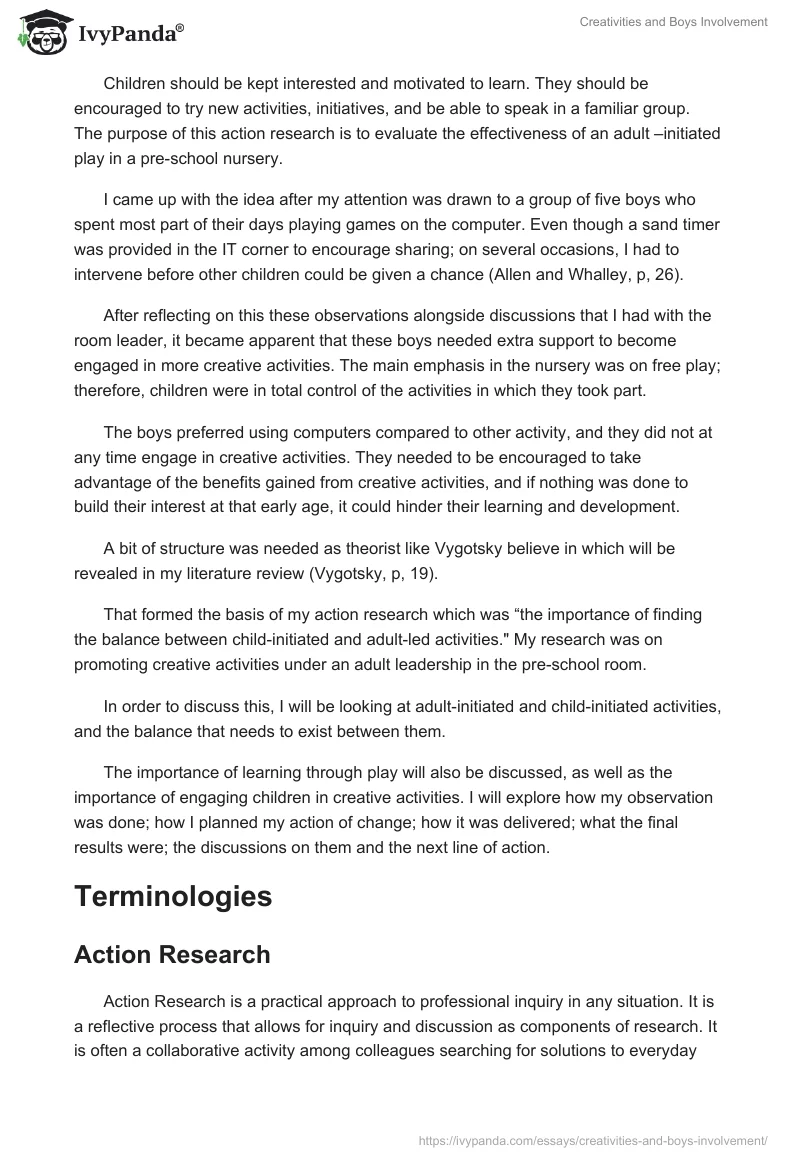Introduction
The Early Years Foundation Stage (EYFS) noted that the creativity among children has to be enhanced by supporting their curiosity, exploration and play. It is also important to provide them with opportunities for exploring and sharing their thoughts, ideas, and feelings.
This can be achieved through art, music, movement and dance activities among others. Various ways can be used in achieving this through what the children see, hear, smell, touch and feel.
Also, this can be achieved through their expansion and communication of their ideas, thoughts and feelings by using various materials, suitable tools, imaginative and role-play, movement, designing and making, and in using a variety of songs and musical instruments (Department for Education and Skills (DfES), p 9; Allen and Whalley, p, 14).
Learning for young children is a rewarding and enjoyable experience in which they explore, investigate, discover and practice among others like developing their knowledge and skills and understanding their attitudes (Brunner, p 16). During the foundation stage, many of these aspects of learning are brought together effectively through play and learning.
To me, a well-planned play, both indoors and outdoors, is a crucial way in which young children learn with enjoyment and challenge. In playing, they behave in different ways: sometimes their play can be boisterous; sometimes they describe and discuss what they are doing; and sometimes are quiet and reflective (Bilton, p 41).
Under the Personal, Social and Emotional Development, children must be provided with experience and support to help them develop positive sense of themselves and others. They need this support in order to develop their emotional well-being by knowing themselves better and to understand what they can do.
Children should be kept interested and motivated to learn. They should be encouraged to try new activities, initiatives, and be able to speak in a familiar group. The purpose of this action research is to evaluate the effectiveness of an adult –initiated play in a pre-school nursery.
I came up with the idea after my attention was drawn to a group of five boys who spent most part of their days playing games on the computer. Even though a sand timer was provided in the IT corner to encourage sharing; on several occasions, I had to intervene before other children could be given a chance (Allen and Whalley, p, 26).
After reflecting on this these observations alongside discussions that I had with the room leader, it became apparent that these boys needed extra support to become engaged in more creative activities. The main emphasis in the nursery was on free play; therefore, children were in total control of the activities in which they took part.
The boys preferred using computers compared to other activity, and they did not at any time engage in creative activities. They needed to be encouraged to take advantage of the benefits gained from creative activities, and if nothing was done to build their interest at that early age, it could hinder their learning and development.
A bit of structure was needed as theorist like Vygotsky believe in which will be revealed in my literature review (Vygotsky, p, 19).
That formed the basis of my action research which was “the importance of finding the balance between child-initiated and adult-led activities.” My research was on promoting creative activities under an adult leadership in the pre-school room.
In order to discuss this, I will be looking at adult-initiated and child-initiated activities, and the balance that needs to exist between them.
The importance of learning through play will also be discussed, as well as the importance of engaging children in creative activities. I will explore how my observation was done; how I planned my action of change; how it was delivered; what the final results were; the discussions on them and the next line of action.
Terminologies
Action Research
Action Research is a practical approach to professional inquiry in any situation. It is a reflective process that allows for inquiry and discussion as components of research. It is often a collaborative activity among colleagues searching for solutions to everyday and real problems experienced in a setting or school. It could also be looking for ways to improve instruction and increase student or pupil achievement (Riel, p, 14).
Action research is a research needed to change practice when you realize that things are not going as planned or you need to implement a new initiative but you are unsure on how to do it effectively. It allows practitioners to address those concerns that are close to them; one in which they can exhibit some influence and make changes.
It is a way of learning from one’s practice by working through a series of reflective stages that facilitate the development of a better way of doing things. With time, action research will help unveil a deep understanding the way in which a variety of social and environmental forces interact to create complex patterns. Since these forces are dynamic, action research is a process of putting one’s theory into practice.
It runs in cycles; that is, one reflects on a practice; take action; reflect again on the result; and further action taken. The subject of an action research is the action done while the design may come from an individual. As it goes through cycles, it widens the number of stakeholders since it makes it more effective this way.
Change cannot be effective without the participation of an entire team, and is usually important to involve as much team members as possible or better still, involve everyone if possible.
Process of Action Research
The process of action research is a spiral form of research which involves different cycles. Therefore, the process goes like this: Study and Plan, Take action, Collect and Analyze evidence, Reflect on results and Study and Plan again and go through the whole process again. This is illustrated in the diagram below, and this cycle is what I will be using for my research:

(Riel, p 33)
For others, it is observe, reflect, plan and act, and observe and reflect on the results again and go through the whole cycle again. An example of this shown using the diagram below:

McNiff (p 50)
Creativity
This is another terminology that will be used in this essay, and is fundamental to successful learning. Being creative enables children to make best connections between various areas of learning and thus enhance their understanding. This area of learning includes art, music, dance, role play and imaginative play. Creativity is viewed as “the minds best work” (Boden, p, 20).
Creative development is a key area within the EYFS: Children’s creativity must be extended by the provision to support for their curiosity, exploration and play. They must be provided with opportunities to explore and share their thoughts, ideas and feelings through art, music, movement, dance, imaginative and role play activities, mathematics and design and technology (DfES, p 11).
Through creative processes, children can develop concentration, problem solving, planning and persistence. Working together encourages a sense of self-respect and valuing others. Communication and language and literacy are also encouraged through speaking and listening, and creative activities like sharing resources.
Knowledge and understanding of the world is developed through investigations that occur when children are presented with unfamiliar materials.
Physical development is enhanced through creative lessons like when sculpting where fine motor skill happens, whereas gross motor skills can be enhanced through dance, poise and developing body control. In fact, all the six areas of learning can be affected by creativity. That is why creativity is critical, and every child must be encouraged to participate (Duffy, p 27).
For this to be successful, practitioners should create a stimulating environment in which creativity, originality and expressiveness are valued. There should be a wide range of activities that children can respond to so as to utilize their many senses and opportunities.
There should also be time for children to express their ideas through a wide range of representations. This would help if children work alongside other creative adults as they will help maximize results.
Play
Play is defined as behavior that is freely chosen; personally directed; and intrinsically motivated, and not performed for an external goal or reward. Play includes a range of self-chosen activities undertaken for their own interest, enjoyment and satisfaction that results for children.
It does not meet basic physical survival needs, but it does seem to support children’s emotional well-being, as well as a wide range of learning within their whole development. It has been asserted that play reinforces development and learning among children. Children spontaneously engage in play, although some may require adult assistance (Department for Education and Skills (DfES), p 9).
Literature Review
Adult-led and Child-initiated Learning
Play is a vital aspect in a child’s development both physically and emotionally. However, my opinion is that it is not in the best interest of the child to be left alone to play all time, or left to choose what they want to do and when they want to do it most of the time.
This view is supported by Vygotsky (p 31) who stresses the importance of a supportive active role of an adult in maximizing children’s intellectual development. He also contends that children succeed in performing tasks and solving problems when helped by an adult.
Brunner (p 17) believes that an adult’s presence increases the richness and length of play. To him, the adults’ role is that of “scaffolding” the child’s learning. These arguments confirm that appropriate intervention and a structured approach to teaching are components of effective pre-school practices (Brunner, p 18).
Philosophers such as Piaget, an advocate of child initiated play, made a statement which implies to me that not everything is learned through play. In this case, other factors should come into force to enhance the other areas of child development.
According to Piaget, as much as play is important, it is not through play that children learn to wash and sleep. This means everything cannot be learnt through play. I believe that as much as children are allowed to play, some structures should be put in place as well.
According to Piaget, children act out their already established behaviors or schemata in play and adapt reality to fit these (Piaget, p 52). On using his daughter Jacqueline’s pretending to sleep as an example, Piaget wrote:
It is clearly impossible to explain this symbolic practice as being pre-exercise; the child certainly does not play like this to learn to wash and sleep. All that he is trying to do is to use freely his individual powers, to reproduce his own actions for the pleasure of seeing himself do them and showing them off to others, in a word to express himself, to assimilate without being hampered by the need to accommodate at the same time (Piaget, p, 53).
For Tina Bruce, she believed in the free flow of play and draws on the chaos theory as a model for play. She asserted that play is at its peak of fruitfulness when it is flowing freely. This meant that it is at this stage that problem-solving takes place and a symbolic representation of their experience occurs in a very creative, spontaneous and intellectual order.
Children need space and provision for this opportunity for this to happen in a very safe environment. In line with Bruce’s argument, children’s should not only be engaged in child-initiated activities all the time. There should be a good balance between child-initiated and adult-led activities.
There is need for free-flow and structured learning initiated by the adult, or in this instance, the early year’s practitioner. This will avail them of the opportunity to access other activities that they otherwise would not have been engaged in, especially, creative activities which will enhance their development (Bruce, p 56).
According to EYFS, in the delineation of creativity as stated above, there are various activities which children need to indulge in to help improve their creative thinking and build upon them. Scaffolding learning can provide a valuable tool for enabling children to develop creative thinking (Brooker, p 4).
In this way, the educator supports the learner to help build on his or her previous knowledge and learn new information in order to achieve the intended outcome of the activity based on the Vygotskian concept of zone of proximal development. This refers to the gap between what the child can achieve without help, and what the child can achieve with appropriate support (Vygotsky, p 19).
It is suggested that when children are supported this way, it help them explore the potential of ideas which in turn helps develop their confidence in their own abilities, and further refine and share their ideas with children and adults as well (Blandford and Knowles, p 27).
My primary concern in this research was a group of boys in the Pre-School. There is a presupposition in the common generalizations that boys are out-performed by girls which implies that boys are not as academically inclined as girls. There was the need to verify this claim scientifically (Connolly, p 46). Smith (p, 35) on conducting some baseline testing came up with findings like:
- Twice as many boys as girls fell into the bottom attainment category as failing to reach accepted standards.
- That girls outnumbered boys by about 30 percent in top group.
The explanation from scientist according to Smith also came up with the findings that there is a less brain activity in boys because of their testosterone production which starts at six weeks of a male embryo. This causes the corpus callous between the brains not to interact properly compared with that of females, which co-operate efficiently with each other (Smith, p. 37).
An example given was that in language development, girls use the whole brain whilst boys use only their left brain. Bearing this scientific fact in mind, I decided to always engage boys in the pre-school room. I based my decision to carry out this research after observing a group of about five boys were always on the computer playing games in the pre-school, or were out in the garden playing.
During the early days of my placement, I had to use a sand timer to encourage sharing the use of the computer. They resisted the idea of using the timer and did not want to give up on the time they had on the computer. After much persuasion, they would reluctantly allow other children access, and then they would run out to the garden to play for a while before coming back to the computer once it was free.
Planning
The purpose of my research was to see if I could engage those boys in other creative activities like painting, music and dance and role play instead of being on the computer most of the time. Even though some creativity could be achieved through ICT, engaging in other creative activities will be more enriching and shall broaden their knowledge and experience.
A variety of experience is what is recommended under the EYFS. This was to help them acquire huge benefits that comes with creativity and to give other children the chance to share the use of the computer as well. Engaging those boys in creative activities so as not to miss out on activities that were good for their social, emotional and physical development was vital to me.
I had to plan how much time the research would take since I was only there for a short time. I chose to run the action for over a week and decided to involve the whole team of adults in the room from room leader to agency staff.
The practitioners had to explain to the children about the activities for the day, explaining that every child would have a turn. The children would choose which nursery nurse they wanted, and what time they wanted to have their activity done.
By so doing, it gave the children an opportunity to have a say in what was going to happen. I then planned with my team of four adults who were to run the first session, the second, third and fourth. Two sessions were to be done before lunch, and the other two immediately after the group readings which usually took place after lunch.
The plan was that by tea time, all children would have a go and no one would have been left out. Once a group was going through with their activity, the plan was that I will be observing the children, and the room leader or any adult who was free will then observe whilst I take my group through the activity.
Actions
This prompted me to have a few discussions with the room leader and other adults in the room about this practice. Also, I enquired about what other activities these children could undertake in building their interest and awareness in the class room like art and craft area where a lot of creative activities were going on.
Occasionally, the boys would access the role play area or the construction area, but would never get involved in painting or any form of creative activity during the period of my observation. The room leader confirmed this, but she was of the opinion that there was no point in getting the children to be involved in activities they were not interested. She believed in child-initiated and led way of learning.
This resistance made it difficult for me to get my subject of action research across initially; however, I had to explain to her that giving all the children an opportunity of experiencing, enjoying, and above all learning from all the activities that were set up in their room was vital to their development.
I advocated for the importance of adult-led way of learning even though I believed in children being given the chance to have a voice in the choice of activities. They needed to be engaged and directed, and if nothing was put in place to support these children, they could be missing out on very important aspects of their early experience such as benefits derived from creative activity.
Having reflected on my observations and the discussions with the other staff, I decided to do this action research for the reason that as a good Early Years Professional, I should have high expectations of myself and others including the children and staff in my setting.
One of the key characteristics of the social pedagogue is the ability to reflect critically on one’s own practice and on the practices within setting, with strong self-awareness (Whalley, p, 52).
Skilled reflection was an integral part of decision-making, and if based on sound judgment, it offers a crucial aspect in the preparation to meeting the Early Years Professional standards, 38 and 39 which focus on leading practice.
The way to see oneself as a reflective practitioner and how to enable others become more reflective, and in particular, and how to analyze both strengths can lead to actions of change to develop areas in the setting (Whalley, p, 54).
This is exactly what I did in coming up with this action research. Therefore, I followed one of the key characteristics of a social pedagogue, which is teaching of younger children. The action ran for a week, and before the start of each day, the creative action that was supposed to take place was explained to them.
A small discussion then took place so that adults could explain further what needed to be done and how. This was also an opportunity for children to ask question that may be on their minds.
I divided the children into four groups with a nursery nurse of their choice, and the time slot they were supposed to participate in their activity. The adults were involved in an activity as much as the children during their turn. By the end of the day, everyone was supposed to come out with a painting of their favorite pet in the first day.
For the next four days, the activities were role play (doctors and nurses and mums and babies); card making; and clay modeling. On the fifth day, focus was on music and movements; we sang songs and danced to the favorite music. An opportunity was given to children to sing any song that they had made about their favorite pets. This made children to be interested and we all knew who had what animal as a favorite pet.
Children were encouraged to share and interact nicely with each other. While these activities were being carried on, two adults were observing what was going on. The observation was on checking to see how involved the children are; their interaction with adults as well as their peers; how they are sharing resource; and above all, how engaged with each other.
Results: evidence collected and analysed
The result was significant; the children were really engaged in the activities. In fact, as the days passed, some of them would come to school in the morning asking about what the day’s activity was going to be. The interaction between the children and adults was also improved. It felt as if the whole class had become lively.
The five boys did spent less time on the computer, and got involved in other activities apart from the days’ main programme. I was pleasantly surprised at the results the other practitioners came up with, and all their report and my own observations goes to confirm Vygotsky’s theory that an adult support leads to maximization of a child intellectual development.
Reflection and conclusion
Jones and Pound (p 23) states that leaders can encourage staff to develop action research. This research has enabled me to lead, practice and develop a learning community. By the end of my research, the children were actively accessing other areas in the setting instead of just using the computer. Further research needs to be done in this area because this is the practice in other recognized settings of high quality.
It is important for practitioners to share knowledge with other high achieving settings. Due to the brevity of my stay, I was unable to further develop this action. However, I have made an action plan to discuss with the manager on how best to proceed with this. I am of the conviction that children can learn more with the help of a supportive adult.
Works Cited
Allen, Shirley and Mary E. Whalley. Supporting Pedagogy and Practice in Early Years Settings. Exeter: Learning Matters Ltd, 2010, print.
Bilton, Helen. Outdoor Play in Early Years. 2nd Ed. London: David Fulton, 2003, print.
Blandford, Sonia and Catherine Knowles. Developing Professional Practice 0-7, England, Pearson Education Limited, 2009, print.
Brooker, Liz. Supporting Transition in the Early Years. Berkshire Open University Press, 2008, print.
Bruce, Tina. Early Childhood Education. Hodder Arnold Education,1997, print.
Brunner, Jerome. Child’s Talk: Learning to Use Language. Oxford: Oxford University Press, 1983, print.
Boden, A. Margaret. The Creative Mind: Myths and Mechanism. London: Weidenfeld and Nicolson, 1990, print.
Connolly, Paul. Boys and Schooling in the Early Years. London: Routlegde, 2004, print.
Department for Education and Skills (DfES). Statutory Framework for the Foundation Stage: Setting the Standards for Learning Development and Care for children from birth to five (EYFS). Nottingham: DfES Publications, 2007, print
Duffy, Bernadette. Creativity and Imagination on the Early Years, Maidenhead: Open University Press, 2006, print.
Jones, Caroline and Linda Pound. Leadership and Management in the Early Years. Berkshire: Open University Press, 2008, print.
McNiff, Jean. Action Research, Principles and Practice. London: Routledge, 1988, print.
Piaget, Jean. Play, Dreams and Imitation in Childhood. London: Heinemann, 1951, print.
Riel, Margaret. Understanding Action Research, Centre for Collaborative Action Research. Pepperdine University, 2010, print.
Smith, Alistair. Accelerated Learning in the Classroom. Stafford: Network Educational Press Ltd, 1996, print.
Vygotsky, S. Lev. Thought and Language. Cambridge, MA: MIT Press, 1962, print.
Whalley, E. Mary. Leading Practice in the Early Years. Exeter: Learning Matters, 2008, print.


